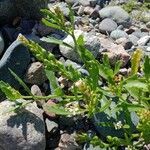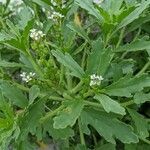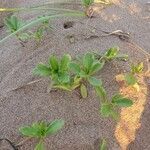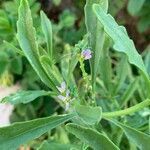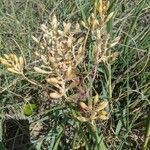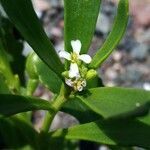Annuals or, rarely, perennials, (compact, rarely sprawling) . Stems erect, or, rarely, prostrate, (much-branched), to 8 dm. Cauline leaves: blade ovate to spatulate, or (distal) oblanceolate (less lobed), (smaller distally), margins crenate, dentate, or sinuate (not pinnatifid). Racemes 1-2 dm, (congested); rachis straight. Fruiting pedicels 1.8-8 mm. Flowers: sepals 3.5-5 mm, lateral pair not saccate basally; petals white to pale lavender, (well-developed or reduced to bristles), 4.6-9.7 × 1.5-3 mm, claw not distinct. Fruits (4-angled or 8-ribbed), cylindrical, 12-29 × 3-9 mm; proximal segment terete, (5-10 mm); terminal segment fusiform to turbinate, (7-15 mm), (beak flattened), apex acute, blunt, or retuse. Seeds: cotyledons accumbent to, sometimes, incumbent.
Stems 30-60 cm tall, much-branched from base, stout, glabrous, sprawling to suberect, forking; main stem often flexuous. Rosette lvs fleshy, obovate to oblanceolate, shallowly pinnatifid, petiolate, 4-6 × 1.5-3 cm; margins serrate; stem lvs narrower and shorter, oblanceolate, obtuse, bluntly serrate. Infl. rachis flexuous, thickening and elongating at fruiting. Pedicels suberect to spreading, 1-3 mm long. Fls 6-8 mm diam., clustered. Petals 4-6 × 1-1.5 mm. Silique erect, (12)-15-22 × 4-7 mm; upper segment ovate, acuminate, tapering to a narrow winged beak, emarginate, 4-angled or 8-ribbed, somewhat flattened, frequently persistent if lower segment seedless, 8-13 mm long; lower segment terete, barrel-shaped, often obconic, (4)-6-9 mm long, without lateral horns.
Annual, succulent herb, branched, decumbent below, spreading-ascending above, to 80 cm tall. Leaves succulent, petiolate, ovate, obovate, or spathulate; lobing various (not pinnatifid); upper leaves reducing, less lobed. lnflorescence a congested raceme. Sepals 3.5–5 mm long. Petals 4.6–8 mm long, white, pink or lavender. Silicula 12–24 mm long, 4–8 mm wide, articulating between the two dimorphic segments, on spreading pedicels to 8 mm long; upper segment 7–15 mm long, compressed-turbinate, 4-angled, acute, obtuse or retuse; lower segment 5–10 mm long, cylindrical to slightly obconical, articulating surface with 2–6 small teeth, seed of lower segment smaller than that of upper.
A cabbage family herb. It is an annual herb. The stems are erect or bend upwards. The branches are spreading and up to 60 cm long. They are succulent. The leaves are broadly sword shaped. They have a lobes and a few blunt teeth. They are 3-6 cm long. The flowers are lilac coloured. The fruit are narrow and rocket shaped with one bump near the tip. These pods are 2.5 cm long.
